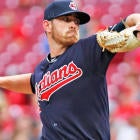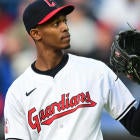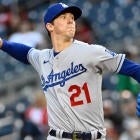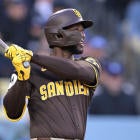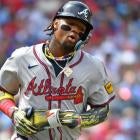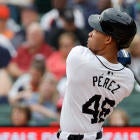Get ready to build a winning team on Draft Day with SportsLine.com's exclusive stats, tools, and projections. Download the Draft Kit with rankings, tiers, auction values, player breakdowns, projections, and more.
Before I engage in character assassination, let me just say: I like Shane Bieber. His minor league numbers were a thing of beauty, and I was excited to see how effectively his plus command, paired with what appeared to be above-average strikeout efficacy, would play up at the major-league level.
To date, he has compiled more than five times as many strikeouts as walks en route to sterling fielding independent pitching metrics (3.23 FIP, 3.30 xFIP, 3.45 SIERA). The slider has been filthy, compiling a 26.2% swinging strike rate (Swstr%). As roughly the 40th starting pitcher off the board per National Fantasy Baseball Championship (NFBC) average draft position (ADP), you could do worse for a mid- to back-end rotation arm.
Still, in peeking under the hood, I couldn't get past a couple of statistical oddities related to his debut. His fastball, seemingly subpar, struck out far more hitters than one might expect; his slider, seemingly excellent, struck out far fewer hitters than expected. I derive those expectations from some prior work I've completed, more recently updated in this Tweet: the average four-seamer or slider generates a strikeout on roughly 50% to 60% of swinging strikes. (In other words, for every swinging strike generated, you can expect, more precisely, something like 0.51 to 0.58 strikeouts.) By this measure, Bieber's four-seamer, with its 1.25 strikeout-to-whiff ratio (K/SwStr), struck out hitters more than twice as often as the league-average four-seamer; his slider, with its 0.31 K/SwStr, struck out hitters about 40% less often.
The disparities are extreme, but Bieber is extreme, too. Anything can happen in 110 innings and change. We can deviate so far from expectations simply because of sample size, and half a season's work, despite seeming like one, is simply not a large enough sample. Still, I wanted to suspend disbelief and investigate if Bieber, firmly in the upper 10th percentile in zone rate (Zone%) and strikeout-to-walk ratio (K/BB), might be able to attribute his varying degrees of strikeout success to his uncommonly good command.
An Unexpectedly Good Fastball?
The single most alarming descriptor of the success (or lack thereof) of Bieber's fastball is its swinging strike rate (SwStr%). At 4.9%, it clocks in well below average, even for four-seamers, which are, in and of themselves, below-average in this regard. A bad fastball, though, does not preclude Bieber from success; even in scrounging for comparables, I turned up examples of good pitchers with bad fastballs, at least by measure of whiff rate. I filtered Statcast data for four-seamers thrown at least 750 times in 2018 with a whiff rate somewhere between 4% and 6%, returning a list of 16 pitchers including Carlos Carrasco, Zack Greinke, Chris Archer, Cole Hamels, Carlos Rodon, and Kyle Freeland. This is not entirely bad company.
All of the pitchers on this list, though, were consistently less efficient than Bieber in converting swinging strikes to strikeouts:
| Name | SwStr% | K% |
|---|---|---|
| Shane Bieber | 4.9% | 22.9% |
| Andrew Suarez | 4.3% | 18.5% |
| Zack Greinke | 4.7% | 18.2% |
| Chris Archer | 5.9% | 17.1% |
| Carlos Carrasco | 6.0% | 16.7% |
| Kyle Freeland | 5.6% | 15.5% |
| Dan Straily | 5.2% | 14.0% |
| Antonio Senzatela | 4.9% | 12.9% |
| Daniel Mengden | 5.8% | 12.9% |
| Cole Hamels | 5.4% | 12.7% |
| Lucas Giolito | 4.7% | 12.4% |
| David Hess | 5.3% | 12.2% |
| Jakob Junis | 5.4% | 10.7% |
| Carlos Rodon | 5.4% | 8.9% |
| Tyson Ross | 5.0% | 8.9% |
| Mike Montgomery | 4% | 8% |
It stands to reason, on this basis alone, that Bieber can't reasonably sustain such a high rate of strikeouts on such a low rate of whiffs. Still, I'm unwilling yet to dismiss the outside possibility that Bieber is a statistical unicorn. Bieber ranks top-20 for zone rate on his four-seamer, which, given his high overall zone rate, is unsurprising. In glancing at the names surpassing and generally surrounding Bieber's on this particular leaderboard, though, a couple of disparities stand out like sore thumbs:
- The swing rate (Swing%) on Bieber's four-seamer (41.9%) is far lower than any other four-seamer ahead or behind his. In fact, it ranks in the bottom 20. It should not surprise you, then, to learn Bieber, with an uncanny ability to find the zone but somehow prevent hitters from swinging, carried the third-highest called strike rate among four-seamers last year.
- Every four-seamer with a higher zone rate, and even several four-seamers with lower zone rates, than Bieber's four-seamer has a swinging strike rate that rates anywhere from slightly better to significantly better. His elevated contact rate on swings ranks 12th-worst among four-seamers thrown 750 time.
One might reckon Bieber, who pounds the zone with a very hittable fastball, is playing with fire. One might reckon it's only a matter of time before hitters simply exhibit more aggression against Bieber, whose fastball steals strikeouts like a bandit on non-swings but gets absolutely punished otherwise.
What's interesting, though — but arithmetically sensible, upon further consideration — is the four-seamers with the highest rates of called strikes also share among the lowest rates of swinging strikes:
| Name | CallStr% | SwStr% |
|---|---|---|
| Zack Greinke | 28.5% | 4.7% |
| James Shields | 27.3% | 3.2% |
| Shane Bieber | 25.8% | 4.9% |
| Chad Bettis | 23.4% | 3.2% |
| Alex Cobb | 23.3% | 3.6% |
| Trevor Richards | 22.9% | 3.5% |
Some of these names would've shown up in my original filter had I not restricted the low end to a 4% minimum SwStr%. Still, even in widening the net I've cast, Bieber's fastball still turns up anomalous, outstripping other high-zone, low-swing, high-contact fastballs by anywhere from 4 to almost 18 percentage points of strikeout rate. Greinke might be Bieber's best-case scenario — Greinke has persisted beyond his expected shelf life largely in part to perhaps baseball's most effectively-used bad fastball — and yet even Greinke can't muster as lofty a strikeout rate as Bieber did last year.
I think a lot of forces will yank and tug on Bieber's fastball next year. When The Book™ on Bieber is out, it should — not necessarily will, but should — become less efficacious in its ability to steal strikes and, thus, strikeouts. It's an extremely vulnerable pitch otherwise, making Bieber's high batting average on balls in play (BABIP) last year seem like a foregone conclusion this year.
It'd be unwise to make foregone conclusions, though, without first discussing his slider.
An Unexpectedly Bad Slider?
Only four sliders thrown at least 400 times last year recorded better swinging strike rates than Bieber's and its 26.2% clip. It's reasonable to expect this number to decrease, given how big of an outlier it is in a relatively small sample. Or, it could increase! We don't know yet. But it's safest to err on the side of caution and assume, after only 408 thrown, it's not quite a 98th-percentile breaking ball.
No matter your expectation of his slider's true talent level, it's immediately evident the pitch lags relative to the pack:
| Name | SwStr% | K% |
|---|---|---|
| Tanner Scott | 29.3% | 60.8% |
| Patrick Corbin | 29.1% | 54.6% |
| Edwin Diaz | 28.4% | 56.4% |
| Kyle Gibson | 26.8% | 46.6% |
| Shane Bieber | 26.2% | 27.7% |
| Max Scherzer | 26.1% | 37.6% |
| Carlos Carrasco | 25.8% | 42.2% |
| Dylan Bundy | 25.6% | 53.9% |
| Noah Syndergaard | 25.2% | 41.0% |
| Kenta Maeda | 24.2% | 35.3% |
The big question, then: what underpins his slider's relatively low strikeout efficacy? That is, what makes his slider so much less whiffy than, say, Carlos Carrasco's or (to name a less-talented arm) Dylan Bundy's? Is it bad luck, or is it self-inflicted?
Usage. Bieber threw his slider 23% of the time in 2018 and also 23% in two-strike counts. For Carrasco, it's 31% and 38%, respectively; for Bundy, 25% and 44%. For Patrick Corbin, King of Sliders, it's 41% and a whopping 65%. Whether knowingly or not, Bieber fails to optimize in a pretty dramatic way. His slider isn't bad; his usage is.
The Verdict
Bieber willingly chooses to throw inferior pitches in advantageous counts, boosting the value of his four-seamer and suppressing the value of his slider. While it's easy to point to his .356 BABIP and call it bad luck, much of it Bieber brings upon himself by nature of his personal game theory.
That's not to say Bieber's fastball is a bad pitch in and of itself; his excellent command helps it steal strikes and results in a very tidy walk rate. But even Greinke, King of Called Strikes with a Bad Fastball (lots of kings I'm crowning today), can't muster a strikeout rate quite as lofty as that which Bieber's fastball achieves. There will be some regression there, especially if he stops using it in two-strike counts. But, all else being equal his fastball will rack up strikeouts at an uncharacteristically brisk pace thanks to his ability to place a pitch.
The problematic part is Bieber's fastball is immensely hittable. Hitters swing more than 60% of the time in two-strike counts, whereas the average swing rate (all counts) is roughly 47%. In other words, hitters are predisposed to offer at a two-strike pitch. Throwing a contact-oriented pitch in counts in swing-happy counts inherently helps opposing hitters. Why not throw a whiff-oriented pitch instead?
With some arsenal optimization, it's within the realm of possibility that Bieber steps forward as a true ace in 2019. But it will require a deliberate, yet relatively simple, change in approach, one that makes him less reliant on himself (his command) and more reliant on others (hitters' plate approach propensities). Sure, it might result in an extra walk or two. But it should also result in an extra strikeout or two (or three, or four) as well as less-harmful contact allowed.
Without optimization, he's not significantly better than Dylan Bundy, a decidedly mediocre arm who owns one of baseball's best sliders and worst fastballs simultaneously. With optimization, Bieber turns the Indians' rotation into the most fearsome in baseball and generates an enormous return on investment for Fantasy players. Bieber is already one of Fantasy baseball's great wide-awake sleepers heading into 2019, but he may have more untapped potential than we realize.
So which Fantasy Baseball sleepers should you snatch in your draft? And which undervalued pitchers can help you win a championship? Visit SportsLine now to get Fantasy Baseball rankings for every single position, all from the model that called Scooter Gennett's huge breakout last season, and find out.












